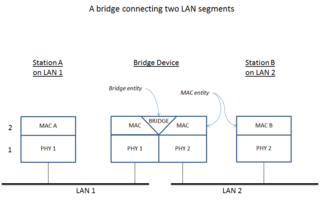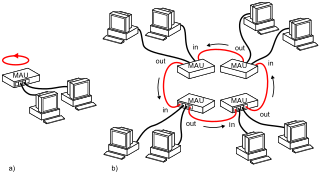
Ethernet is a family of computer networking technologies commonly used in local area networks (LAN), metropolitan area networks (MAN) and wide area networks (WAN). It was commercially introduced in 1980 and first standardized in 1983 as IEEE 802.3, and has since retained a good deal of backward compatibility and been refined to support higher bit rates and longer link distances. Over time, Ethernet has largely replaced competing wired LAN technologies such as Token Ring, FDDI and ARCNET.
A media access control address of a device is a unique identifier assigned to a network interface controller (NIC). For communications within a network segment, it is used as a network address for most IEEE 802 network technologies, including Ethernet, Wi-Fi, and Bluetooth. Within the Open Systems Interconnection (OSI) model, MAC addresses are used in the medium access control protocol sublayer of the data link layer. As typically represented, MAC addresses are recognizable as six groups of two hexadecimal digits, separated by hyphens, colons, or no separator.
A network switch is a computer networking device that connects devices on a computer network by using packet switching to receive, process, and forward data to the destination device.

In computer networking, Fast Ethernet physical layers carry traffic at the nominal rate of 100 Mbit/s. The prior Ethernet speed was 10 Mbit/s. Of the Fast Ethernet physical layers, 100BASE-TX is by far the most common.
In the seven-layer OSI model of computer networking, the physical layer or layer 1 is the first and lowest layer. This layer may be implemented by a PHY chip.
A virtual LAN (VLAN) is any broadcast domain that is partitioned and isolated in a computer network at the data link layer. LAN is the abbreviation for local area network and in this context virtual refers to a physical object recreated and altered by additional logic. VLANs work by applying tags to network frames and handling these tags in networking systems – creating the appearance and functionality of network traffic that is physically on a single network but acts as if it is split between separate networks. In this way, VLANs can keep network applications separate despite being connected to the same physical network, and without requiring multiple sets of cabling and networking devices to be deployed.

In IEEE 802 LAN/MAN standards, the medium access control (MAC) sublayer and the logical link control (LLC) sublayer together make up the data link layer. Within that data link layer, the LLC provides flow control and multiplexing for the logical link, while the MAC provides flow control and multiplexing for the transmission medium.

A network interface controller is a computer hardware component that connects a computer to a computer network.

In computer networking, the term link aggregation applies to various methods of combining (aggregating) multiple network connections in parallel in order to increase throughput beyond what a single connection could sustain, and to provide redundancy in case one of the links should fail. A Link Aggregation Group (LAG) combines a number of physical ports together to make a single high-bandwidth data path, so as to implement the traffic load sharing among the member ports in the group and to enhance the connection reliability.

A network bridge is a computer networking device that creates a single aggregate network from multiple communication networks or network segments. This function is called network bridging. Bridging is distinct from routing. Routing allows multiple networks to communicate independently and yet remain separate, whereas bridging connects two separate networks as if they were a single network. In the OSI model, bridging is performed in the data link layer. If one or more segments of the bridged network are wireless, the device is known as a wireless bridge.
Multiple Registration Protocol (MRP), which replaced Generic Attribute Registration Protocol (GARP), is a generic registration framework defined by the IEEE 802.1ak amendment to the IEEE 802.1Q standard. MRP allows bridges, switches or other similar devices to be able to register and de-register attribute values, such as VLAN identifiers and multicast group membership across a large LAN. MRP operates at the Data Link Layer.

A home network or home area network (HAN) is a type of computer network that facilitates communication among devices within the close vicinity of a home. Devices capable of participating in this network, for example, smart devices such as network printers and handheld mobile computers, often gain enhanced emergent capabilities through their ability to interact. These additional capabilities can be used to increase the quality of life inside the home in a variety of ways, such as automation of repetitive tasks, increased personal productivity, enhanced home security, and easier access to entertainment.
In computer networking, jumbo frames are Ethernet frames with more than 1500 bytes of payload, the limit set by the IEEE 802.3 standard. Conventionally, jumbo frames can carry up to 9000 bytes of payload, but variations exist and some care must be taken using the term. Many Gigabit Ethernet switches and Gigabit Ethernet network interface cards can support jumbo frames. Some Fast Ethernet switches and Fast Ethernet network interface cards can also support jumbo frames.

Token Ring local area network (LAN) technology is a communications protocol for local area networks. It uses a special three-byte frame called a "token" that travels around a logical "ring" of workstations or servers. This token passing is a channel access method providing fair access for all stations, and eliminating the collisions of contention-based access methods.
40 Gigabit Ethernet (40GbE) and 100 Gigabit Ethernet (100GbE) are groups of computer networking technologies for transmitting Ethernet frames at rates of 40 and 100 gigabits per second (Gbit/s), respectively. The technology was first defined by the IEEE 802.3ba-2010 standard and later by the 802.3bg-2011, 802.3bj-2014, and 802.3bm-2015 standards.
IEEE 802.1ad is an Ethernet networking standard informally known as QinQ and is an amendment to IEEE standard IEEE 802.1Q-1998. The technique is also known as provider bridging, Stacked VLANs, or simply QinQ or Q-in-Q. "Q-in-Q" can for supported devices apply to C-tag stacking on C-tag but this has limited application in the modern methodology of network routing.

Open vSwitch, sometimes abbreviated as OVS, is an open-source implementation of a distributed virtual multilayer switch. The main purpose of Open vSwitch is to provide a switching stack for hardware virtualization environments, while supporting multiple protocols and standards used in computer networks.









